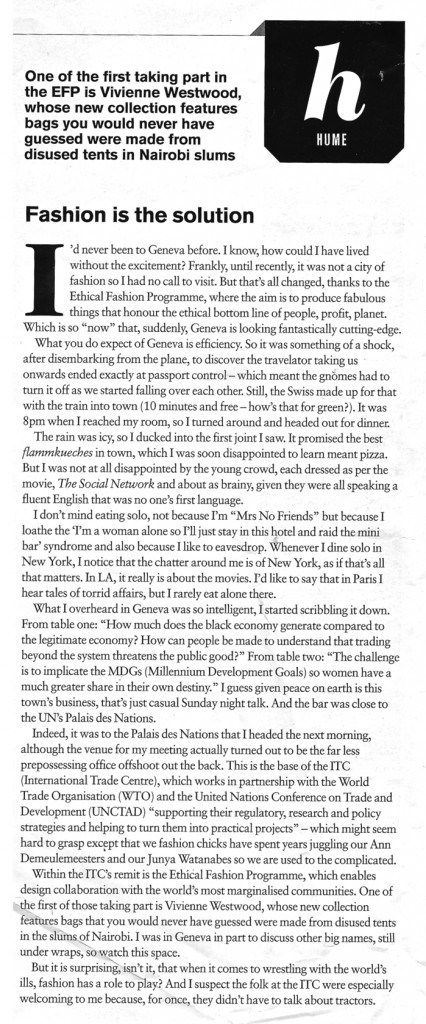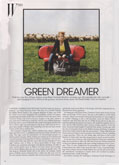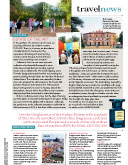Yearly Archives: 2011
A Lesson Learned – AUSTRALIAN FINANCIAL REVIEW
A Lesson Learned
A gaggle of women in full-on African dress were utterly perplexed by a moving staircase going up to the stars. One gingerly places a foot on a tread, shrieked and fled.
AFR | August 2011
by Marion Hume
Before reaching air-side at Kenyatta International Airport, I was halted at a security desk manned by those doing something most unusual for their rather serious job; they were giggling. It’s true the scene ahead was, in a purely slapstick sense, rather funny. A gaggle of women in full Africna dress were utterly perplexed by a moving staircase going up to the stars. One gingerly places a foot on a trend, shrieked and fled. Another started slapping the rubber handrail as if it were a snake she must kill to stop it moving-at which point the immigration official who had raised his arm to stamp my exit visa bit into his sleeve to stop himself laughing out loud.
Passport stamped at last, I walked towards the high escalator and stepped on to it to gasps of astonishment. Next, a young girl was behind me, shrieking with glee. “See, it’s OK,” I said, before raising my right leg slowly , indicating how to step off again. While I was running late for the Nairobi-London night flight, I hung around just long enough to see others of the group emerge over the top from what. by the look on their delighted faces, has been the ride of their lives.
We all travel so much these days, it’s a struggle to remember our own first time. But to travel, to transit your fist airport, to fly, when you come from a country mired in poverty, is an even more extraordinary thing. Of course not even Kenyan is poor- far from it- but my sense was these women were certainly not Nairobi cosmopolitans. By the time they reached the top of the escalator, their eyes were sparkling with both astonishment and a sense of achievement. They’d conquered something and they hadn’t even left the country.
Still, one must always be wary of stereotyping. I recently worked with a Kenyan cameraman who told me how an international director had shown him some footage shot by his foreign team. Seeing a filthy little toddler digging in the mud with a stick, the cameraman suggested it might not be a great idea to use that sequence but was ignored.
Months later, a mother watching her flat screen TV was furious when she spotted her son being used in one of those bulletins urging us to flex out credit cards for charity. “Don’t those people’s kids ever sit in the yard?” she shouted. (That, and demanding to know why, when the images of kids from rich countries are protected, no one though to so much as ask whether a mother might be equally protective of her little boy). The cameraman said he’d heard that parents in New York and London have become so scared, they never let their kids just be kids, sitting in the sun digging for worms.
Wherever my escalator ladies were headed, I hope there are people to guide them through the subtleties of their new location. For while I was only able to teach them the not wildly complicated skill of how to ride an escalator, what they gave me in exchange was more profound.
If we are lucky in our working lives, we are forever fronting up to new experience. Yet sometimes, I know that makes me nervous and now I now realise that the terminology we use is partly to blame. Why would I relish risking going ‘out on the wire’ when I lack the balancing skills of a circus performer? But stepping on to an escalator, going up? I can do that. So from now on, I’m going to remember the Kenyatta escalator ladies when I need reminding that the new isn’t always to be feared. It can be fun.
Green Dreamer – Ilaria Venturini Fendi – W
Green Dreamer
With her new line of bags, fashion scion Ilaria Venturini Fendi is spinning cast-off materials into chic carryalls-and changing lives in Africa in the process. Marion Hume meets the Fendi family’s first eco-warrior.
By Marion Hume
W | July 2011
“ I never understood why recycling had to be cheap or amateur,” says Ilaria Venturini Fendi. “But then, I’m a Fendi!” Indeed, the bubbly blonde Italian is the youngest daughter or Anna, one of the five Fendi sisters who re-imagined the possibilities of fur and leather transforming the family atelier into a worldwide brand. Her sister Silvia Venturini Fendi is the head accessories designer at the label, which is now under the LVMH luxury umbrella. And her niece Delfina Delettrez Fendi has made a name for herself with a goth-meets-glam jewellery line. Yet it is Ilaria, right now powering her jeep down a dirt track on her organic farm outside of Rome, who is proving to be the true style revolutionary of the famous fashion clan.
Her Carmina Cmpus line-which includes totes, purses, computer bags, and iPad covers- is grabbing attention for using old stuff in new ways. The Bags, made my communities of disadvantaged people, are about as green as it gets. Many of them are created out of reclaimed and recycled material including leftover fabrics, old blankets, and even discarded soda-bottle caps. But let’s nip in the bud any thought of “eco-ugly” fashion- this is Made in Africa-meets- Made in Italy, which translates into exuberant style fused with flawless finishing. On offer at such rarefied global stores as Milan’s 10 Corso Como and London’s Dover Street Market, these are not your average do-gooder totes. The bag slung at Venturini Fendi’s feet as she drives for example, blends pieces of khaki canvas reclaimed from a safari tent (the ones used for five-star tourism become unusable after several seasons) with artisanal patchwork made from off-cuts of the kanga cloths that comprise the traditional East African garment.
Growing up in the Fendi atelier, Venturini Fendi made dresses for her dolls out of scraps. “I hate waste,” she says as she brakes to avoid a flock of sheep. “Always surrounded with precious materials, we were taught to be careful.” Farming is also in the bloodline, from her father, Giulio Venturini, who dies when she was 10. While his day job was in the construction industry his passion was nature. He taught his daughter how to ride, and she still remembers their country outings together. As for her farm, Venturini Fendi brought I Casali del Pino nearly a decade ago, with the aim of turning her back on the fashion business for being “so passive about what really mattered, like the environment.” Today milk from the aforementioned sheep is used to produce four kinds of cheese, including tangy pecorino. There are also ducks, pigs and hens as well as two donkeys so ludicrously tame they keep trying to nuzzle up and say hello.
It was her bees, however, that lured Venturini Fendi into producing high-end accessories in Africa. In 2007 the University of Rome asked her to share her apiarist insights with some visiting beekeepers from Cameroon. They, in turn, thanked her by presenting her with a traditional Cameroonian hat, which looks somewhat like a crazy crocheted hedgehog. Once a Fendi, always a Fendi: Rather than put the gift on her head, she immediately re-imagined it upside down and trimmed in leather, transformed into a funky little bag.
Just before meeting the beekeepers, Venturini Fendi has begun to miss the world she thought she’d left for good. She had reconfigured her greenhouse into a design studio, where she has been joined by a clutch of former colleagues from the days when she’s worked at Fendissime, in the Ninties, a youthful secondary line that was shuttered after LVMH purchased Fendi. The team’s goal: to figure out how discarded materials could be refashioned at the highest possible level. The results, plus those created by other eco-minded designers, would soon be sold at Re(f)use, a green emporium that Venturini Fendi set up in a family owned building in the heart of Rome.
Putting the hat-turned-bag into production involved a group trip to Dschang, the Cameroonian town from which the bobby berets originate. (Both men and women wear them,” she says. “They look incredible.”) After forging a collaboration if with local artisans, however, she was left with questions: How was she to know if she was paying workers too little or- just as damaging in a fragile economy-too much? For answers, Venturini Fendi turned to Simone Ciprani, on officer at the Ethical Fashion Programme of the International Trade Centre, which is the joint body of the United Nations and the World Trade Organization. (Full disclosure: the author consults for the program.) The mission of the Ethical Fashion Programme is to harness fashion as a vehicle out of poverty, connecting the world’s most marginalized people to plugged-in designers in Paris, New York, Milan and elsewhere. Production of the hat-bags continues at a small scale in Cameroon, while artisans in Kenya produce a wider range of styles. Carmina Campus employs 69 Kenyans full time, many from the notorious Nairobi slums of Korogocho and Kibera. “It is about real people with faces and names and stories, who live in a different way now,” says Cipriani, who can’t help but be impressed by Venturini Fendi. “I was astonished to see her in the dump sites of the slums, talking with the people for a long time. It is not an easy place.”
Venturini Fendi’s latest project is a three-way collaboration between Carmina Campus, the ITC, and 10 Corso Como owner Carla Sozzani. This time the bags, which just made their debut at Sozzani’s Milan boutique, are lined and trimmed with leftovers from 10 Corso Como’s signature collections- but they are finished in Africa. “What I didn’t like when I was in fashion before was that what you created was gone in a season,” Venturini Fendi says. “Now I want ot make lovely things that last. When I hear that other designers want to do the same, I am happy.” Indeed Vivienne Westwood, who is also passionate about the environment, is collaborating with the ITC in Kenya-both women believe fashion’s aspirational aura allows the industry to punch above its weight when it comes to getting notices. In this lies a route to real change, and while moving fashion away from a trend-driven model is quite a lofty aim, forging a new path, has after all, been in the Fendi DNA for several generations.
“I want fashion to be the promoter of change,” says Venturini Fendi as she exits her jeep for a walk along the river that flows though her farm, “to the point that there will no longer be any need to make a distinction between fashion and ethical fashion.”
Estate of the Art-Collezione Gori
Estate of the Art – Collezione Gori
by Marion Hume
In the gardens of a Tuscan manor house, an inspiring collection by modern masters. TUSCANY There is, of course, an abundance of celebrated art in Tuscany, but the experience of looking at it amidst jostling crowds is rarely tranquil. And what if your taste is for something more modern?
Collezione Gori is a rare treat: a private collection of art beautifully displayed in some 24 hectares of parkland surrounding a grand Tuscan manor called Celle. The estate displays some 70 works designed precisely for their surroundings by artists including Anselm Kiefer, Ian Hamilton Finlay and Richard Serra. The collection was started by Giuliano Gori, who acquired the old mansion in the Tuscan hills between Florence and Pistoia, in the 1970s and set about inviting artists to come to Tuscany, absorb the atmosphere, choose where they would like to see a creation displayed and then be funded to make that happen.
Entry to Collezione Gori is free, but the days of turning up at the gates on a bicycle and be let in are long gone. Today, you must write to the gallery well in advance- although the good news, as the collection prepares to celebrate its 30th anniversary in 2012, is that there will be more summer open days than in the recent years. Current artworks include a house of mirrors by Daniel Buren, a bamboo pathway to infinity and a couple of giant eggs.
Now structural renovations are complete, it’s also possible to enjoy the seventeenth century chapel, historic fountains and stonework in the garden next to the house. As well as modern installations – keep eyes peeled for the Marta Pan and two Dani Karavan works- other treats include a number of 19th century whimsies such as an aviary, a tea house and an Egyptian monument. The landscaping, inspired by the English stately homes, includes two small lakes with crags and a waterfall. Amid all this is the unmissable My Sky Hole by Bukichi Inoue. Set in the olive grove, it sets visitors on a meditative journey through an outdoor corridor, down an underground tunnel and back up a spiral staircase into the light of a large glass cube.
For details on how to apply for a visit go to goricoll.it and allow at least six weeks notice.





